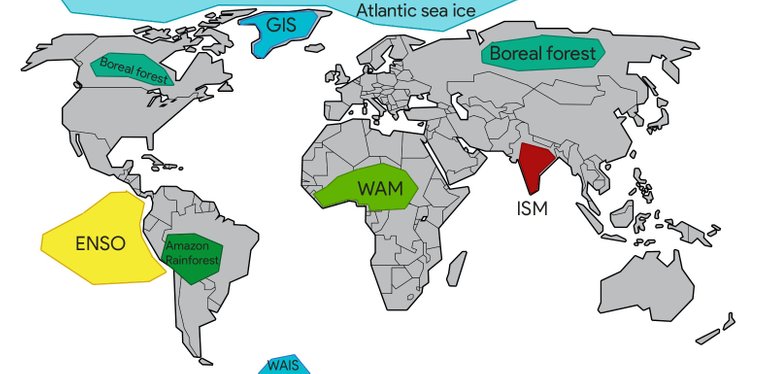
The earth's climate is full of balances that developed over time. But balances can be altered and some are characterized by a tipping point. This tipping point is a critical threshold at which a balance can be permanently tipped over and change after the threshold occurs faster than the cause could induce. Even when the forcing that pushed the scales is removed, a tipped balance can no longer reach its former equilibrium. Therefor such tipping points should be of everyone's interest since changes are often irreversible. An example of such a tipping point is the melting of the Greenland ice sheet. It is estimated that an increase of 2 to 4 degrees Celsius would cause a positive feedback loop resulting in the melt of the entire ice sheet. I would like to share some of the relevant tipping points that are affected by human forcing, and point out how much/little we know about it, or what the implications would be of a tipped balance in the next 100 years. It's quite a long article, so pick a few tipping points you are interested in or go through them all if you are really interested.
Greenland Ice Sheet or GIS
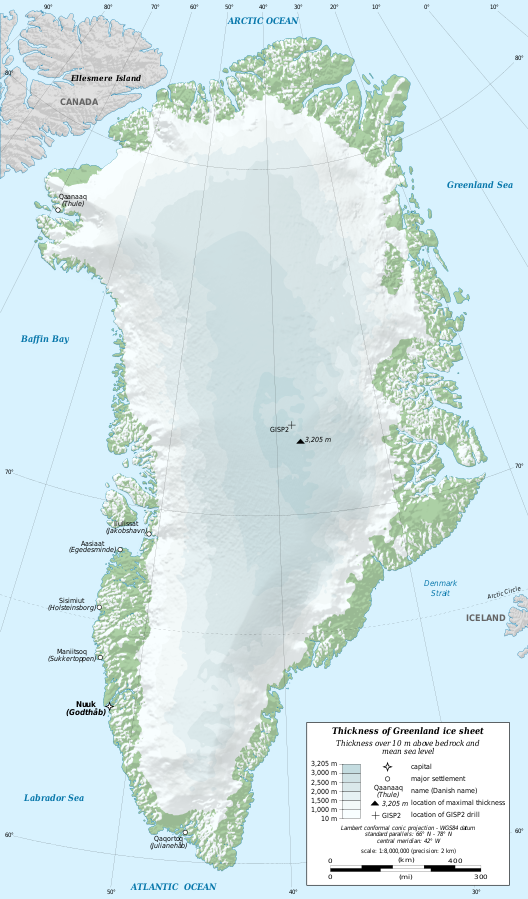
Map by Eric Gaba, published under CC BY-SA 3.0
I'll start with the, to my opinion, most commonly known tipping point. The GIS is a remnant of the many glacial periods and ice would be present for as long as 18 million years. To put this in perspective, this is slightly older than the first occurrence of great apes/hominids such as the bonobo, gorilla or chimpanzee. The ice sheet lies at a great height (approx. 2100 m/7000 ft) and since temperature decreases the higher you go, this allowed the greenland to maintain its ice during warmer periods that do not necessarily sustain an ice sheet. Since the end of the last ice age about 11.000 years ago, this is again the case. current climate does not support ice on Greenland but it is the height that keeps it stable. The danger here lies that a warming to a certain threshold melts the ice to a certain height, after which it can no longer sustain itself and melts completely. An estimated 2 to 4°C warming is needed to pass this tipping point. Inland glaciers in higher mountains could remain but the majority of the overland ice sheet would melt in a time span of thousand years or more.
When this happens, and all melt water is released in the sea, it will contribute to a sea-level rise of 7 meters over the next millennium. The bedrock underneath the GIS has been pushed below the sea level due to weight of the ice, except for the mountains along the edges. If the ice would melt, Greenland would most likely turn into an archipelago until isostatic rebound lifts the surface above sea level again. This is also what is happening to the Baltic region, which was also covered with an ice sheet in the last ice age.
Arctic Sea-Ice
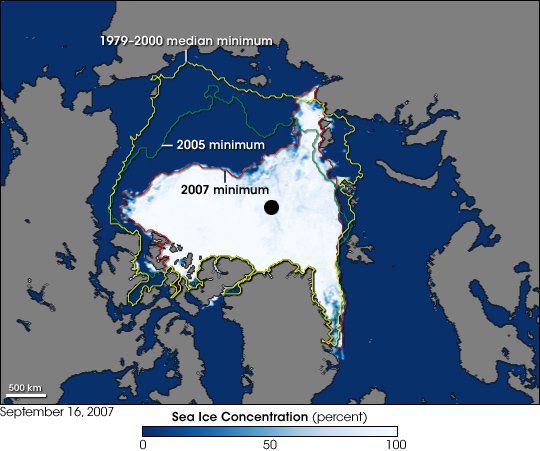
surrounding the Greenland Ice Sheet is about 12 million square kilometers or 4.6 million square miles of arctic sea-ice. The properties of the ice currently allow a lot of solar radiance to be reflected back into space (high albedo) and this is what could cause a feedback loop. When sea-ice melts it exposes a much darker ocean surface which absorbs the sun's energy rather than reflecting it. This in return increases temperature which again supports the melting of more sea-ice. Currently already a strong decline in sea-ice is measured and some suggest the tipping point has already been passed, but not everyone agrees to this. The International Panel on Climate Change (IPCC) ran several models regarding the arctic sea-ice for different emmission pathways. Half of the models became completely free of ice during the warmest period somewhere in this century, while only two simulations predict complete loss of sea-ice under extreme conditions. A clear critical threshold has not yet been defined. The models of the IPCC are also met with a lot of uncertainty but significant change is very well possible during this century.
West Antarctic Ice Sheet or WAIS
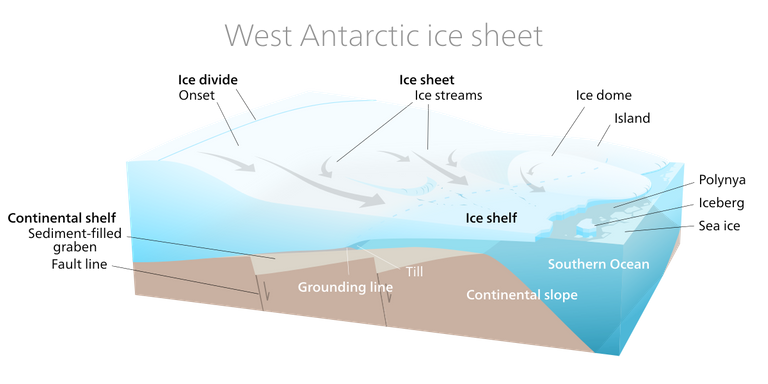
Illustration by Kelvinsong licensed under CC BY-SA 3.0
While we are at it I will continue with the other major ice sheet on this planet, Antarctica. In general, Antarctica is considered stable. It is completely surrounded by ocean water which isolate it from warm water or air flows. This is also why the Antarctic sea-ice is in less danger. In the last decades only little warming has been observed. There is however one potential point that can collapse. The West Antarctic Ice Sheet lies on bedrock that has sunk below sea level and slopes land inwards. If the ice retreats only a little, ocean water may undercut the ice sheet which strongly induces further calving of ice shelves. It would require a local warming of about 5°C for summer temperatures to exceed the melting point. Since colder regions are influenced more by a global temperature rise it is possible that this 5°C is already reached with a global increase of only a few degrees. Currently the WAIS is losing mass and glaciers are losing 60% more ice mass than they gain from snowfall. The IPCC does not propose an exact threshold but some expect that the tipping point might be reached in this century. Also the timescale of the consequences is yet highly uncertain but in a worse case scenario, where the ice sheet collapses in 300 years, sea-level would rise by 1 meter per century.
A new study, published only two weeks ago, assessed the four decades of antarctic ice sheet mass balance from 1979 until 2017. Surprisingly they concluded that other glaciers are prone to ice loss as well.
Atlantic Thermohaline Circulation or THC

Image by NASA/JPL
Ok, this will be the last tipping point regarding ice or melting, I promise. The THC is the waterflow that distributes warm water to the poles, and cold water back to the equator. This flow of water is largely driven by differences in density, temperature and salt content. But when a significant amount of freshwater gets released near the Atlantic, this density driven water current might be halted. Almost all models show a collapse of the circulation and in some this is still reversible after forcing is removed. But how sensitive this circulation is, is poorly studied. However, the IPCC summarizes that a sudden collapse of the THC is 'very unlikely' in the following century but a transition is 'likely' after that.
El Nino-Southern Oscillation or ENSO
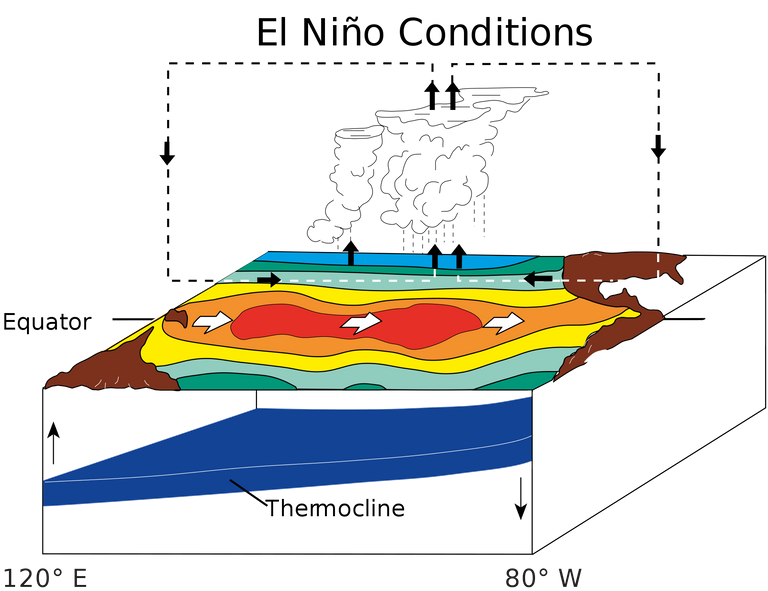
the occurrence of ENSO relies on three elements. The depth of the thermocline in ocean water, the slope of the thermocline and finally the temperature gradient across the equator. When the oceans take up more heat, this can push the thermocline to larger depths, inducing more intense and/or more frequent ENSO. But on the opposite is it expected that easterly winds become more intense which would force more cold water to the surface, reducing the intensity and/or frequency of the ENSO. However, most models predict a shift to a more intense ENSO with similar frequency as today but the probability of these statements are still highly uncertain.
Amazon Rainforest
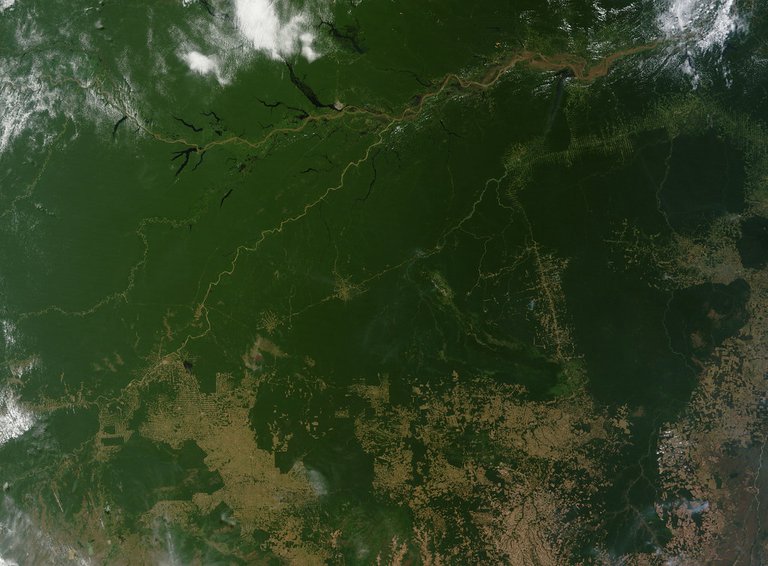
The amazon rainforest induces a lot of evaporation and transpiration, which again induces more rain on the continent. Because of this, precipitation measures are higher than they would normally without vegetation. About 20 to 30% of the precipitation originates from this effect. In another way, it is the evapotranspiration that allows to maintain high precipitation and thus the rainforest itself. If however, land use changes significantly, we might reduce the recycled precipitation to a point where the rainforest can no longer sustain itself. Again, no threshold has been stated for this feedback loop.
Boreal Forest

under further rise of global temperatures, large-scale withdrawal of boreal forest is expected. increasing temperatures will lead to increased water stress, higher peak temperatures during summer and increased vulnerability to fire and disease. Yet, temperate tree species are not able to immigrate since winter temperatures remain too cold. This would result in a decrease of forest and an increase in open woodlands or grasslands. This threshold is estimated at around 3°C of global warming but due to limitations in the models and understanding of the phenomenon, uncertainty is high.
Indian Summer Monsoon or ISM

Illustration from Saravask shared under CC BY-SA 3.0
Monsoon circulation is driven by the pressure gradient between the atmosphere above the land and the ocean. any forcings that weakens this pressure gradient can potentially destabilize the circulation. Atmospheric warming tends to be stronger over land and thus can strengthen the monsoon, but increased albedo over land due to land cover changes tend to reduce warming over land.
Models predict that the regional albedo needs to exceed 0.5 for the ISM to collapse, which is similar to the albedo of snow and clouds. Even then would increasing CO2 concentrations stabilize the monsoon. IPCC projections also do not show a threshold and conclude that there is no direct danger. They do however acknowledge that additional aerosols in the atmosphere from air pollution might additionally weaken the ISM.
West African Monsoon or WAM

Illustration from Encyclopædia Britannica, Inc.
The Sahara and Sahel region are only fairly recent transformed to a desert. Until about 5000 years ago, vegetation was still present in the Sahara. The circulation that could bring precipitation to this region (WAM) is affected by sea surface temperature differences between the two hemispheres. Greenhouse gasses are expected to further increase these temperature differences and thereby increasing rainfall. Three models were designed but in both models the WAM actually collapses. In one of the models this leads to a further drying of the Sahel but in the second model, this collapse leads to increased precipitation. For this model to become true, a regional warming of 3°C is required in the Gulf of Guinea. and finally the third model predicts no major trends in amount of precipitation, but it predicts more intense dry years.
What is also observed in the Sahel nowadays is the greening of shrub vegetation. The increase in CO2 content of the atmosphere allows plants to absorb CO2 more efficiently while losing less water. This greening trend in the Sahel, and the WAM models are a rare example of a beneficial tipping element. You can find more about the three models here.
Conclusion
It still amazes me how much uncertainty there is about such large scale tipping points that have such effects in the near future. Maybe more awareness and knowledge about these permanent implications can further influence policy makers or just inspire people to take more actions bottom up.
Thanks for reading, I hope you found my work interesting! If you have any comments, please don't hesitate to leave them behind!
All images that were not attributed are in public domain. If you like to discover new scientific content, definitely check out new articles with the #steemstem tag from @steemstem.
Sources
Cook, K. H., & Vizy, E. K. (2006). Coupled model simulations of the West African monsoon system: Twentieth- and twenty-first-century simulations. Journal of Climate, 19(15), 3681–3703. https://doi.org/10.1175/JCLI3814.1
Gregory, J. M. (2004). Threatened loss of the Greenland Ice-sheet. Nature, 428, 616.
Hanna, E., Navarro, F. J., Pattyn, F., Domingues, C. M., Fettweis, X., Ivins, E. R., … Jay Zwally, H. (2013). Ice-sheet mass balance and climate change. Nature, 498(7452), 51–59. https://doi.org/10.1038/nature12238
Rignot, E., Mouginot, J., Scheuchl, B., van den Broeke, M. R., van Wessem, M. J., & Morlighem, M. (2019). Four decades of Antarctic Ice Sheet mass balance from 1979-2017. Proceedings of the National Academy of Sciences, 1–9. https://doi.org/10.1073/pnas.1812883116
Schellnhuber, H. J. (2009). Tipping elements in the Earth System. Proceedings of the National Academy of Sciences, 106(49), 20561–20563. https://doi.org/10.1073/pnas.0911106106
https://phys.org/news/2018-03-amazon-deforestation.html
https://globalforestatlas.yale.edu/climate-change/climate-change-boreal-forests
http://nsidc.org/arcticseaicenews/
https://en.wikipedia.org/wiki/El_Ni%C3%B1o%E2%80%93Southern_Oscillation
This post has been voted on by the SteemSTEM curation team and voting trail in collaboration with @utopian-io and @curie.
If you appreciate the work we are doing then consider voting all three projects for witness by selecting stem.witness, utopian-io and curie!
For additional information please join us on the SteemSTEM discord and to get to know the rest of the community!
THX steemstem for promoting this important post!
Great post! Resteemed!
Greets from a former student of this subject 🤓
Thank you! I'm glad you found it worth sharing 😃
very good article.
unfortunately we are definitely on track to big f.. up!
Thanks! Things are indeed happening relatively fast, but I also see mentality changes occurring rather quickly, especially in youth and younger generations. Perhaps in a few more years they will gain more influence and be able to further steer the planet into a proper direction.
I don't know how many people have read this article...but not enough. You make such a solid case. You explain so clearly how we are on the brink of climate catastrophe. And we blithely move forward.
I do see a sense of urgency in young people. They seem aware that older generations have stolen their future through foolish, selfish policies.
Will these young people seize the reins of power in time to reverse the damage?
I won't be around to see this (that's pretty certain), but my granddaughter will. I can only hope....
Thanks for your persistence in covering this issue. I'm Tweeting it out.
guys and girls.. lets resteem it!!
@agmoore.. you are completely right!
@samve is a treasure on climate. I will retweet this tomorrow. So far, 28 "impressions", in 19 minutes-- whatever that means.
:)
and art to boot !
on your twitter post? great!
Lets make the EARTH great again! ;-)
Thank you for the feedback! The people from previous centuries could still be excused for lacking the knowledge, but nowadays when information is so well spread, it almost feels like a crime to be ignorant to it. I'm also curious about what the future will bring. I'm pretty sure that humanity and many societies will be able to adapt, but I'm mainly curious about what future society we will shape.
You keep plugging, and we'll keep sharing your great posts. Every voice matters. And you explain the issue so clearly. Doesn't sound like preaching, but it does convey a sense of urgency.
Retweeted my tweet from yesterday a few minutes ago... so far, 113 "impressions". Whatever that means. Tomorrow I'll reblog this post on my Steemit feed.
I really appreciate the commitment and knowledge you bring to this subject.
Thanks must go to @bloom who brought me here by downvoting my content on this subject. Personally I am not in the habit of downvoting that which I don't agree with, but we are all free of course to vote as we choose.
Having read your article I am curious to know if you believe there is a connection between sun spot cycles and the colder periods on Earth?
Personally I believe we are moving into an ice age no matter what we do or don't do. So, in my mind it is better to start learning to live off grid. And even if I am wrong, it will still be a valuable skill to learn.
I appreciate you sharing passionately, regardless of our different beliefs.
Thank you for your comment, I deeply appreciate your openness for other people's opinion and I am surely interested to hear your thoughts about it.
I am absolutely convinced that the cycles in the sun activity have undoubted influence on the earth's climate. Many previous climatic changes have been exactly correlated to those changes. It is indeed true, that the sun is decreasing in activity and that, according to these cycles, we would enter a cooler climate again. But the thing is that current trends in mean global temperature cannot be explained by the solar activity. There is an interesting study about this where they address the opposite trends between solar trends and global air temperature. here is a link to that article. If you can't see the content, Here is a wetransfer with the pdf file https://we.tl/t-g7Y2KCMK9B.
So other forcings must be at play in order to explain current measured global trends. But then why do you think that we will still head towards a cold period?
And indeed depending on the expected future, different strategies will be best. While living off-grid is not necessarily ideal for the future I foresee, being independent and not relying on other large corporations is a lifestyle I can only endorse!
Appriciate the link. I will study it with interest as I am really just trying to understand this subject as best I can. Rather than try to explain my current understanding here I would encourage you to take a look at the article I wrote: https://steemit.com/iceage/@samstonehill/a-cold-reality-we-are-not-ready-for-the-upcoming-ice-age
It was interesting to read the many comments under the post. Strange don't you think that almost everyone is in agreement with my prognosis? Perhaps of course, my followers on steem are just a conspiratorial bunch who enjoy challenging the status quo, or perhaps there really is something to this?
Either way, it is my mission now to get as close to the truth as I can! I have two small children and knowing what to expect for their future is very important to me.
Thank you for being polite with me. Only the best people are able to politely discuss a subject they don't agree with.
Dear @samstonehill,
I would recommend to read through the following web pages:
https://skepticalscience.com/
https://climate.nasa.gov/vital-signs/global-temperature/
In regards to sun spots: This will just be a much much smaller effect than overall global warming...
but you will find it all very properly explained on those web pages...
in regards to @bloom .. I understand your feelings.. however you have to see that people as him and me who for decades try to bring global warming science to the public just feel tired of hearing the same wrong claims by non scientists (the sources you are referring to are either not written by climate scientists or long outdated )over and over again..
also I have to give you credit that you made a very nice post...
maybe you find the links useful and let them impact your knowledge base a bit.. as you seem to be a caring and engaged person...
You have however a point in aiming for an independent living style...
the first thing you could do: Install a solar PV array.. and get independent from you dirty power supplier...
Thank you, it is indeed nice to have civil conversations like this when two people do not have the same points of view. I have read to post already quickly, but I'll go through it and give my honest thoughts.
I must admit that I am also susceptible to the confirmation bias, where one tends to read what only confirms his beliefs, so It's a good practice to be open to other's points of view.
Hi @samve!
Your post was upvoted by @steem-ua, new Steem dApp, using UserAuthority for algorithmic post curation!
Your UA account score is currently 2.576 which ranks you at #15476 across all Steem accounts.
Your rank has improved 19 places in the last three days (old rank 15495).
In our last Algorithmic Curation Round, consisting of 249 contributions, your post is ranked at #193.
Evaluation of your UA score:
Feel free to join our @steem-ua Discord server
Congratulations! Your post has been selected as a daily Steemit truffle! It is listed on rank 25 of all contributions awarded today. You can find the TOP DAILY TRUFFLE PICKS HERE.
I upvoted your contribution because to my mind your post is at least 6 SBD worth and should receive 271 votes. It's now up to the lovely Steemit community to make this come true.
I am
TrufflePig, an Artificial Intelligence Bot that helps minnows and content curators using Machine Learning. If you are curious how I select content, you can find an explanation here!Have a nice day and sincerely yours,

TrufflePigactually the first time @trufflepig promotes such an article.. that is really cool...
will look on truffelpigs list now more closely again..
would have hope so it makes it into the top 10.. ;-)
Hi @samve!
Your post was upvoted by Utopian.io in cooperation with @steemstem - supporting knowledge, innovation and technological advancement on the Steem Blockchain.
Contribute to Open Source with utopian.io
Learn how to contribute on our website and join the new open source economy.
Want to chat? Join the Utopian Community on Discord https://discord.gg/h52nFrV
Congratulations @samve!
You raised your level and are now a Minnow!